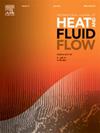金属泡沫聚氯乙烯集热器与建筑采暖通风室耦合的参数分析
IF 2.6
3区 工程技术
Q2 ENGINEERING, MECHANICAL
International Journal of Heat and Fluid Flow
Pub Date : 2025-07-23
DOI:10.1016/j.ijheatfluidflow.2025.109985
引用次数: 0
摘要
本研究数值研究了混合光电热(PVT)太阳能集热器与通风房间之间的热与动态集成,以实现高效的可再生供暖。为了加强热传递,金属泡沫层被嵌入光伏电池下面。本研究考虑了两个不同的领域:假设层流在PVT风道中,并使用基于有限体积法的内部FORTRAN代码进行模拟,而假设通风室内的湍流,并使用ANSYS Fluent使用标准k -ε湍流模型进行模拟。通过综合参数分析,评价了入口气流速度、多孔介质孔隙度、达西数、无量纲多孔层厚度等关键参数对系统整体性能的影响。结果表明,孔隙度从0.2增加到0.98,电效率从12.2%降低到9%。然而,当进气速度分别为0.2、0.3、0.4和0.5 m/s时,热效率分别提高了67%、52%、45%和35%。在高达西数(Da≥10−3)时,将多孔层厚度增加到0.8,系统性能得到提高,热效率、电效率和平均室温分别提高47.8%、22%和23%。本文章由计算机程序翻译,如有差异,请以英文原文为准。
Parametric analysis of a metal foam-based PVT collector coupled with a ventilated room for building heating
This study numerically investigates the thermal and dynamic integration between a hybrid photovoltaic-thermal (PVT) solar collector and a ventilated room for efficient renewable heating. To enhance heat transfer, a metal foam layer is embedded beneath the photovoltaic cells. Two distinct domains are considered in this study: laminar flow is assumed in the PVT air channel and simulated using an in-house FORTRAN code based on the finite volume method, while turbulent flow is assumed in the ventilated room and simulated using ANSYS Fluent with the standard k–ε turbulence model. A comprehensive parametric analysis is conducted to evaluate the influence of key parameters, including inlet air velocity, porous medium porosity, Darcy number, and the dimensionless porous layer thickness, on the overall system performance. The results indicate that increasing the porosity from 0.2 to 0.98 reduces electrical efficiency from 12.2 % to 9 %. However, the thermal efficiency shows gains of 67 %, 52 %, 45 %, and 35 % for inlet air velocities of 0.2, 0.3, 0.4, and 0.5 m/s, respectively. At high Darcy numbers (Da ≥ 10−3), increasing the porous layer thickness up to 0.8 enhances the system performance, leading to improvements of 47.8 %, 22 %, and 23 % in thermal efficiency, electrical efficiency, and average room temperature, respectively.
求助全文
通过发布文献求助,成功后即可免费获取论文全文。
去求助
来源期刊

International Journal of Heat and Fluid Flow
工程技术-工程:机械
CiteScore
5.00
自引率
7.70%
发文量
131
审稿时长
33 days
期刊介绍:
The International Journal of Heat and Fluid Flow welcomes high-quality original contributions on experimental, computational, and physical aspects of convective heat transfer and fluid dynamics relevant to engineering or the environment, including multiphase and microscale flows.
Papers reporting the application of these disciplines to design and development, with emphasis on new technological fields, are also welcomed. Some of these new fields include microscale electronic and mechanical systems; medical and biological systems; and thermal and flow control in both the internal and external environment.
 求助内容:
求助内容: 应助结果提醒方式:
应助结果提醒方式:


